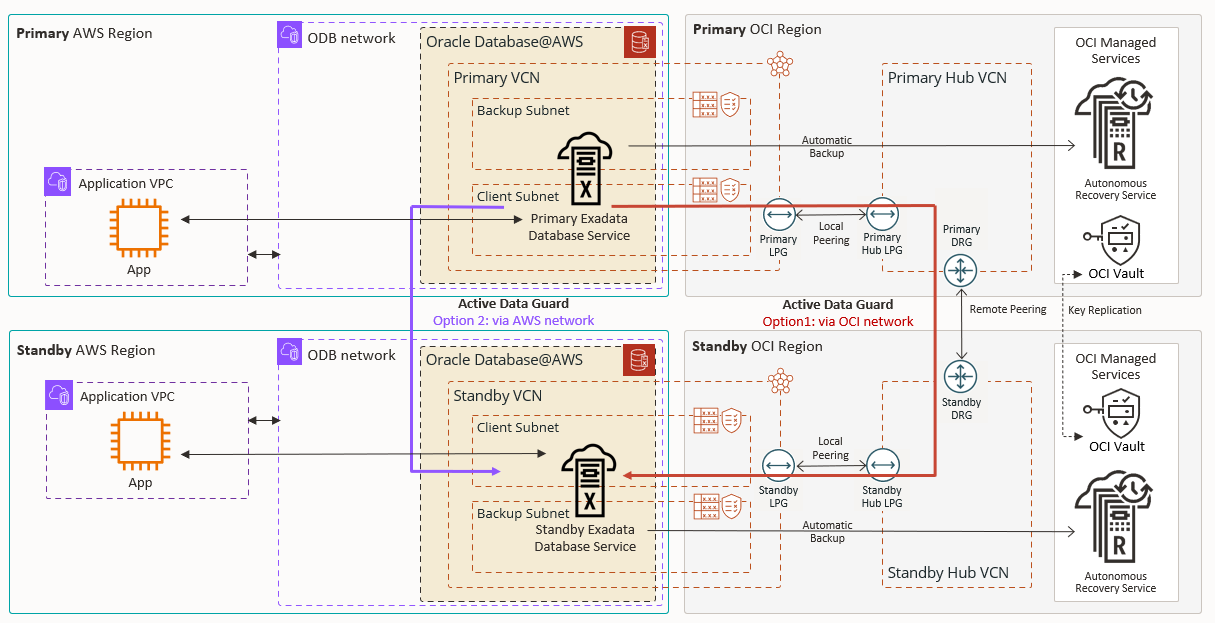We are excited to announce that Oracle Exadata Database Service on Dedicated Infrastructure on Oracle Database@AWS is now certified at the Gold tier of Oracle Maximum Availability Architecture (MAA). This validation confirms that Exadata Database Service on Oracle Database@AWS meets Oracle’s highest standards for high availability and disaster recovery (HA/DR), with support for failover across multiple Amazon Web Services Availability Zones (AWS AZs) as well as across AWS Regions. With Gold MAA certification, Exadata Database Service on Oracle Database@AWS blends cloud flexibility with proven resilience, ensuring your mission-critical workloads stay protected from server failures as well as regional outages.
Oracle Maximum Availability Architecture (MAA): The Gold Standard for Uptime
Oracle MAA has long provided a proven blueprint of best practices for achieving extreme levels of database availability and data protection. It defines multiple tiers (Bronze, Silver, Gold, Platinum) of resiliency, with each higher tier adding more protection. Gold MAA is built for mission-critical applications demanding sub-minute failover and near-zero data loss. It combines Oracle Real Application Clusters (RAC) for local high availability, Oracle Active Data Guard for real-time disaster recovery, and operational best practices around redundancy, updates, and automation. Exadata Database Service on Oracle Database@AWS supports cross-AZ as well as cross-region deployments using this reference architecture, helping enterprises meet strict service level agreements (SLAs) and compliance goals without sacrificing cloud agility.

Figure 1: Oracle Database@AWS MAA Gold Cross-Region Reference Architecture
 What is included in Gold MAA on Oracle Database@AWS?
What is included in Gold MAA on Oracle Database@AWS?
- Active-Active cluster with Oracle RAC: Exadata Database Service on Oracle Database@AWS uses Oracle RAC for HA within a cluster. Active-active database nodes ensure seamless failover and enable rolling maintenance, minimizing planned downtime.
- Active Data Guard Standby across AZs or regions: In a Gold configuration, your primary database can continuously ship redo to a standby database in another AZ or region, providing near real-time replication and zero data loss.
- Comprehensive Backup and Recovery Integration: The MAA Gold tier incorporates Oracle’s best practices for backup and restore using either Object Storage or the Zero Data Loss Autonomous Recovery Service, depending on recovery needs. Object Storage provides regular backups for example daily incremental with archived redo supporting point-in-time recovery. This is suitable for standard RPO requirements. For mission-critical workloads, Recovery Service at OCI delivers continuous protection by capturing real-time redo enabling immediate recovery with zero data loss. It also autonomously validates and secures backups in an isolated recovery zone. Combined with Data Guard, which provides real-time redundancy, this provides multiple levels of data protection.
- Redundant Networking and Storage: Exadata Database Service on Oracle Database@AWS is configured with redundant network connections and mirroring to prevent single points of failure in the infrastructure. In Gold MAA, everything is designed with an “n+1” model, from multiple network paths to mirrored disks and failover capabilities for any component. The architecture includes a pre-configured redundant network topology and ensures that if any one link or component fails, the database remains accessible. This holistic approach extends to Oracle’s unique Exadata storage features as well. Intelligent storage servers that can survive drive failures and continue serving data without impact.
- Minimal Downtime Patching and Upgrades: A key aspect of MAA Gold is handling planned maintenance without disruption. Exadata Database Service on Oracle Database@AWS supports methods for online patching of the database and cluster software. Using a combination of RAC (for rolling patches) and Data Guard (for things like database upgrades via transient logical standby or rolling upgrade), customers can apply many updates with either zero downtime or a few seconds of service interruption at most. For example, quarterly database patches can be applied in a rolling fashion, and even major version upgrades can be done with minimal downtime by doing a controlled switchover to the standby. This keeps you up to date on security and features without jeopardizing your SLAs.
Together, these features provide a validated, end-to-end HA/DR stack that supports continuous operations, even through outages or updates.
Oracle MAA Silver and Gold tiers
| Unplanned outage |
Silver: Recovery point and time objective (RPO and RTO) service level objective |
Gold: RPO and RTO service level objective |
| Recoverable node or instance failure |
Less than 30 seconds | Less than 30 seconds |
| Disasters: Corruptions and site failures |
RTO: Hours to days RPO: Since last backup or near zero with Recovery Service |
RTO: Seconds to minutes RPO: Zero to seconds |
| Planned maintenance |
|
|
| Software and hardware updates |
Zero |
Zero |
| Major database upgrade |
Minutes to 1 hour |
Less than 30 seconds |
To achieve zero downtime or the lowest impact for online processing, apply the MAA application checklist best practices. Oracle Application Continuity (AC) and Transparent Application Continuity (TAC) minimize the impact of outages for applications, effectively turning a potential downtime event into a brief brownout rather than a full outage.
Conclusion: Multicloud Flexibility Meets Enterprise Resilience
Exadata Database Service on Oracle Database@AWS delivers the best of both worlds: the performance and availability of Oracle Exadata with the rich set of native services and manageability in AWS. Now, with Gold MAA certification, enterprises can confidently deploy their most critical Oracle workloads in AWS without compromising uptime or resilience. This is Multicloud done right – run Oracle where your business needs it, backed by an architecture built for resilience, continuity, and transformation.
For more information, see the following resources:
- Read more about the general availability of Oracle Database@AWS
- Learn more about how to use Oracle Database@AWS for simplified Oracle Exadata migrations
- Learn more about Oracle Database@AWS on AWS Marketplace
- View purchase options for Oracle Database@AWS
- Learn more about Oracle Autonomous Database and Oracle Exadata Database Service

